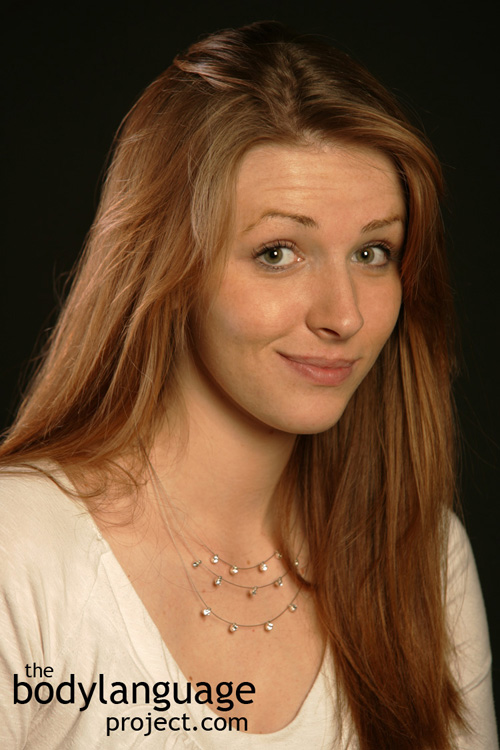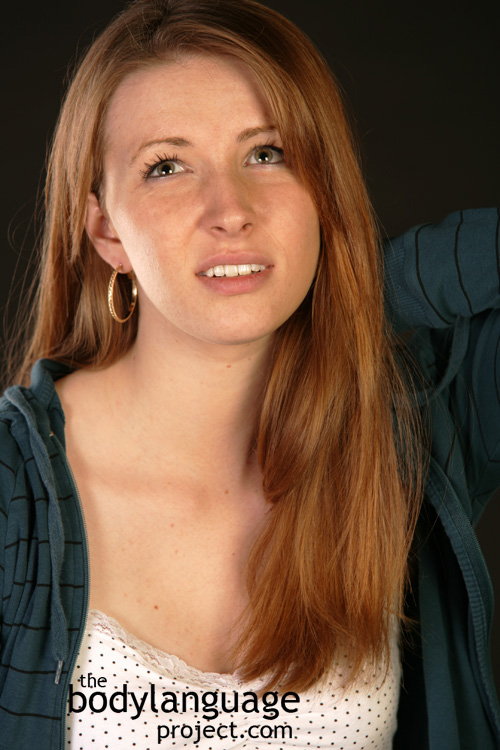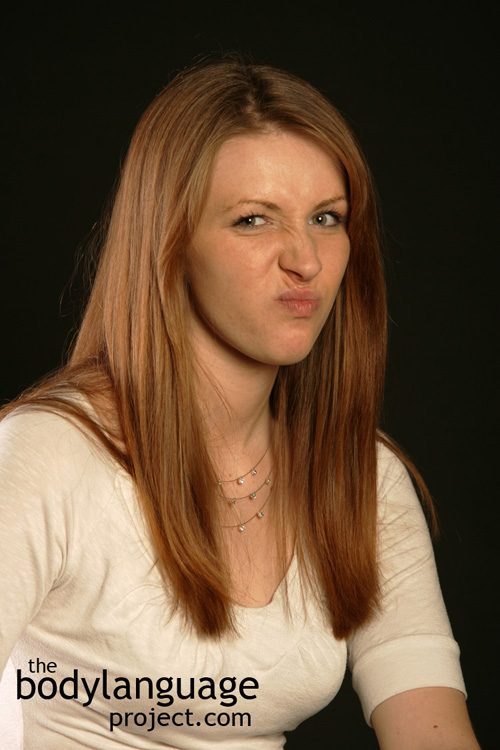Body Language of The Anger Facial Expression
 Cue: Anger Facial Expression
Cue: Anger Facial Expression
Synonym(s): Facial Expression Of Anger.
Description: The anger face is done by lowering the browridge, lowering the brow, raising the cheekbones, widening (flaring) the nose, raising the mouth, thinning the lips, raising the chin bun, and raising the chin raised. The anger face involves Action Units 4, 5, 7 10, 17, 22, 23, and 24.
In One Sentence: The anger face is a signal of strength and used as a bargaining tool to advance the position of the signaler.
How To Use it: Use the angry facial expression to demonstrate the seriousness of your conviction. Research shows that angry faces are more likely to be taken seriously as they are seen as more dominant. Using an angry face is physical proof that one is actually emotionally invested.
Context: General
Verbal Translation: “I’m angry forcing the muscles in my face to contort my eyes and nose.”
Variant: At times the anger facial expression flashes over the face and quickly disappears. Thus, it is a microexpression that wishes to go unnoticed. If this is noticed, it can be trusted as an honest emotion.
See Contempt Facial Expression, Disgust Facial Expression, Fearful Facial Expression, Sadness Facial Expression, Happiness And Joy, Surprised Facial Expression, Eyebrows Knit or Oblique Eyebrows Of Grief.
Cue In Action: A baseball player looked angrily at the pitcher after being beaned in the leg with a pitch.
Meaning and/or Motivation: The intent of the anger facial expression is obvious and universal.
Cue Cluster: The arms go limp to the sides of the body, the chin juts out taunting, the feet point toward the target, fingers may point, chests might be pounded the voice might be raised. We may also see encroaching or distancing and erratic behaviour.
Body Language Category: Anger, Microexpression.
Resources:
Aviezer, Hillel; Ran R. Hassin; Jennifer Ryan; Cheryl Grady; Josh Susskind; Adam Anderson; Morris Moscovitch and Shlomo Bentin. Angry, Disgusted, or Afraid? Studies on the Malleability of Emotion Perception. Psychological Science. 2008. 19(7): 724-732.
http://bodylanguageproject.com/articles/emotions-read-context-study/
App, Betsy; Catherine L. Reed and Daniel N. McIntosh. Relative Contributions Of Face And Body Configurations: Perceiving Emotional State And Motion Intention. Cognition and Emotion. 2012. 26(4): 690-698.
http://bodylanguageproject.com/articles/facial-expressions-versus-bodily-expressions-nonverbal-communication/
Ben-Zeev, Avi; Tara C. Dennehy; Rachel Sackman; Andres Olide and Christopher C. Berger. Flirting With Threat: Social Identity and the Perils of the Female Communality Prescription. Journal of Experimental Social Psychology. 2011. 47: 1308-1311.
http://bodylanguageproject.com/articles/flirting-with-danger-women-flirt-to-avoid-conflict/
Bard, K. A. (2003). Development of emotional expressions in chimpanzees (Pan troglodytes). In P. Ekman, J. Campos, R. J. Davidson & F. B. M. De Waal (Eds.), Emotions inside out: 130 years after Darwin’s The Expression of the Emotions in Man and Animals (Vol. 1000, pp. 88-90). New York: Annals of the New York Academy of Sciences.
Baron, R. M., & Kenny, D. A. (1986). The moderator-mediator variable distinction in social psychological research: Conceptual, strategic, and statistical considerations. Journal of Personality and Social Psychology, 51(6), 1173-1882.
Biehl, M., Matsumoto, D., Ekman, P., Hearn, V., Heider, K., Kudoh, T., et al. (1997). Matsumoto and Ekman’s Japanese and Caucasian Facial Expressions of Emotion (JACFEE): Reliability Data and Cross-National Differences. Journal of Nonverbal
Behavior, 21, 3-21.
Burgoon, Judee K., David B. Buller, and W. Gill Woodall (1989). Nonverbal Communication: The Unspoken Dialogue (New York: Harper & Row).
Carroll E. 1994. Innate and universal facial expressions: Evidence from developmental and cross-cultural research Izard, Psychological Bulletin. 115(2): 288-299.
de Waal, F. B. M. (2003). Darwin’s legacy and the study of primate visual communication. In P. Ekman, J. Campos, R. J. Davidson & F. B. M. De Waal (Eds.), Emotions inside out: 130 years after Darwin’s The Expression of Emotion in Man and Animals (pp. 7-31). New York: New York Academy of Sciences.
Daniele Marzoli, Mariagrazia Custodero, Alessandra Pagliara, and Luca Tommasi. Sun-Induced Frowning Fosters Aggressive Feelings. Cognition And Emotion. 2013; 27 (8): 1513-1521.
http://bodylanguageproject.com/articles/the-sun-can-produce-feelings-of-anger-and-aggression-it-makes-us-frown/
Daniel H. Lee, Reza Mirza, John G. Flanagan and Adam K. Anderson. Optical Origins of Opposing Facial Expression Actions. Psychological Science published online 24 January 2014 DOI: 10.1177/0956797613514451
http://bodylanguageproject.com/articles/eyes-and-facial-expressions-may-be-biologically-controlled-serve-a-real-non-emotional-purpose-says-research/
Darwin, Charles (1872). The Expression of the Emotions in Man and Animals, third edition (New York: Oxford University Press, 1998).
Ekman, Paul, Wallace V. Friesen, and Sylvan S. Tomkins (1971). “Facial Affect Scoring Technique: A First Validity Study.” In Semiotica (Vol. 3), pp. 37-58.
Ekman, P. (1994). Strong evidence for universals in facial expressions: A reply to Russell’s mistaken critique. Psychological Bulletin, 115, 268-287.
Ekman, P., Friesen, W. V., O’Sullivan, M., Chan, A., Diacoyanni-Tarlatzis, I., Heider, K., et al. (1987). Universals and cultural differences in the judgments of facial expressions of emotion. Journal of Personality & Social Psychology, 53(4), 712-717.
Ekman, P., Levenson, R. W., & Friesen, W. V. (1983). Autonomic nervous system activity distinguishes among emotions. Science, 221(4616), 1208-1210.
Ekman, P., O’Sullivan, M., & Matsumoto, D. (1991a). Confusions about context in the judgment of facial expression: A reply to “The contempt expression and the relativity thesis.”. Motivation & Emotion, 15(2), 169-176.
Ekman, P., O’Sullivan, M., & Matsumoto, D. (1991b). Contradictions in the study of contempt: What’s it all about? Reply to Russell. Motivation & Emotion, 15(4), 293-296.
Elfenbein, H. A., & Ambady, N. (2002). On the universality and cultural specificity of emotion recognition: A meta-analysis. Psychological Bulletin, 128(2), 205-235.
Ekman, Paul. 1986. A new pan-cultural facial expression of emotion. Source: Motivation and Emotion Ekman. 10(2): 159-168.
Ekman, Paul and Friesen, W. V. 1987. Universals and cultural differences in the judgments of facial expressions of emotion. Journal of Personality and Social Psychology. 53(4): 712-717.
Ekman, Paul; Friesen, Wallace V. 1971. Constants across cultures in the face and emotion. Journal of Personality and Social Psychology. 17(2): 124-129.
Ekman, Paul. 1972. Universals and cultural differences in facial expressions of emotion. In J. Cole (Ed.), Nebraska Symposium on Motivation, 1971. 19: 207-282. Lincoln: University of Nebraska Press.
Fulcher, J. S. “Voluntary” facial expression in blind and seeing children. Archives of Psychology, 1942. 38: 272.
Friesen, W. V. 1972. Cultural differences in facial expressions in a social situation: An experimental test of the concept of display rules. Unpublished doctoral dissertation, University of California, San Francisco.
Grezes, Julie; Le´onor Philip; Michele Chadwick; Guillaume Dezecache; Robert Soussignan and Laurence Conty. Self-Relevance Appraisal Influences Facial Reactions to Emotional Body Expressions. PLoS ONE. 2013. 8(2): e55885. doi:10.1371/journal.pone.0055885
http://bodylanguageproject.com/articles/face-reacts-body-anger-brains-wired-process-emotional-body-language
Hatz, Jessica L. and Martin J. Bourgeois. Anger as a Cue to Truthfulness. Journal of Experimental Social Psychology. 2010. 46: 680-683.
http://bodylanguageproject.com/articles/anger-nonverbal-cue-truth-telling/
Hareli, Shlomo; Noga Shomrat and Ursula Hess. Emotional Versus Neutral Expressions and Perceptions of Social Dominance and Submissiveness. Emotion. 2009 9(3): 378-384. DOI: 10.1037/a0015958
http://bodylanguageproject.com/articles/dominance-expression-conveyed-different-facial-expressions-men-women/
Kret, Mariska Esther and Beatrice de Gelder. Social Context Influences Recognition of Bodily Expressions. Exp Brain Res. 2010. 203:169-180. DOI 10.1007/s00221-010-2220-8
http://bodylanguageproject.com/articles/context-matters-judging-body-language/
Kret, M. E. and B. de Gelder. When a Smile Becomes a Fist: The Perception of Facial and Bodily Expressions of Emotion in Violent Offenders. Exp Brain Res. 2013. 228: 399-410. DOI 10.1007/s00221-013-3557-6.
http://bodylanguageproject.com/articles/reading-bodily-postures-facial-expressions-incorrectly-can-disastrous-just-ask-violent-offenders/
Levenson, R. W., Ekman, P., & Friesen, W. V. (1990). Voluntary facial action generates emotion-specific autonomic nervous system activity. Psychophysiology, 27(4), 363-384.
Levenson, R. W., Ekman, P., Heider, K., & Friesen, W. V. (1992). Emotion and autonomic nervous system activity in the Minangkabau of West Sumatra. Journal of Personality & Social Psychology, 62(6), 972-988.
Matsumoto, D. (1989). Cultural influences on the perception of emotion. Journal of Cross-Cultural Psychology, 20(1), 92-105.
Matsumoto, D. (1992). American-Japanese cultural differences in the recognition of universal facial expressions. Journal of Cross-Cultural Psychology, 23(1), 72-84.
Matsumoto, D. (2001). Culture and Emotion. In D. Matsumoto (Ed.), The Handbook of Culture and Psychology (pp. 171-194). New York: Oxford University Press.
Matsumoto, D., & Ekman, P. (1989). American-Japanese cultural differences in intensity ratings of facial expressions of emotion. Motivation & Emotion, 13(2), 143-157.
Matsumoto, D., Keltner, D., Shiota, M. N., Frank, M. G., & O’Sullivan, M. (2008). What’s in a face? Facial expressions as signals of discrete emotions. In M. Lewis, J. M. Haviland & L. Feldman Barrett (Eds.), Handbook of emotions (pp. 211-234). New York: Guilford Press.
Matsumoto, D., & Willingham, B. (2009). Spontaneous Facial Expressions of Emotion of Congenitally and Non-Congenitally Blind Individuals. Journal of Personality and Social Psychology, 96(1), 1-10.
Mesquita, B., & Frijda, N. H. (1992). Cultural variations in emotions: A review. Psychological Bulletin, 112, 197-204.
Marzoli, Daniele; Mariagrazia Custodero; Alessandra Pagliara and Luca Tommasi. Sun-Induced Frowning Fosters Aggressive Feelings. Cognition And Emotion. 2013; 27 (8): 1513-1521.
http://bodylanguageproject.com/articles/avoid-anger-sunny-days/
Mondloch, Catherine J.; Nicole L. Nelson and Matthew Horner. Asymmetries of Influence: Differential Effects of Body Postures on Perceptions of Emotional Facial Expressions. PLOS one. September 2013. 8(9): e73605.
http://bodylanguageproject.com/articles/facial-expressions-versus-bodily-expressions-nonverbal-communication-2
McClure, Erin B 2000. A meta-analytic review of sex differences in facial expression processing and their development in infants, children, and adolescents
Psychological Bulletin. 126(3): 424-453.
Mead, M. 1975. Review of “Darwin and facial expression.” Journal of Communication, 25: 209-213.
Nao, Misako Sawada and Motonobu Ishii. Development of the Movements Impressions Emotions Model: Evaluation of Movements and Impressions Related to the Perception of Emotions in Dance. Journal of Nonverbal Behavior. 2013. 37:107-121.
DOI 10.1007/s10919-013-0148-y
http://bodylanguageproject.com/articles/convey-emotion-nonverbally-dance-study/
Nelson, Nicole L and James A. Russell. Children’s Understanding Of Nonverbal Expressions Of Pride. Journal of Experimental Child Psychology. 2012; 111: 379-385.
http://bodylanguageproject.com/articles/can-children-read-pride-body-language/
Petersen, Michael Bang; Daniel Sznycer; Aaron Sell; Leda Cosmides, and John Tooby. The Ancestral Logic of Politics: Upper-Body Strength Regulates Men’s Assertion of Self-Interest Over Economic Redistribution. Psychological Science. 2013. 24(7): 1098-1103. DOI: 10.1177/0956797612466415
http://bodylanguageproject.com/articles/rich-male-vote-left-small-biceps-politics-upper-body-strength/
Peleg, G., Katzir, G., Peleg, O., Kamara, M., Brodsky, L., Hel-Or, H., et al. (2006). Heriditary family signature of facial expression. Proceedings from the National Academy of Sciences, 103(43), 15921-15926.
Russell, James A. 1995. Facial Expressions of Emotion: What Lies Beyond Minimal Universality? Psychological bulletin. 118(3): 379-391.
Russell, James A. 1994. Is There Universal Recognition of Emotion From Facial Expression? A Review of the Cross-Cultural Studies. Psychological Bulletin. 115(1): 102-141.
Russell, James A.; Naoto Suzuki and Noriko Ishida. 1993. Canadian, Greek, and Japanese freely produced emotion labels for facial expressions. Motivation and Emotion. 17(4): 337 -351
Reed, Lawrence, Ian; Peter DeScioli and Steven A. Pinker. The Commitment Function of Angry Facial Expressions. Psychological Science. 2014 DOI: 10.1177/0956797614531027
http://bodylanguageproject.com/articles/anger-facial-expression-gets-people-to-do-what-you-want/
Susskind, Joshua M and Adam K Anderson. Facial Expression Form and Function. Communicative Integrative Biology. 2008. 1(2): 148–149. PMCID: PMC2686004
http://bodylanguageproject.com/articles/emotional-facial-expressions-evolve/
Sell, Aaron,; Cosmides, Leda and Tooby, John. The Human Anger Face Evolved to Enhance Cues of Strength. Evolution and Human Behavior. 2014. 35(5): 425-429.
http://bodylanguageproject.com/articles/the-universal-anger-face/
Sell, Aaron; Liana S. E. Hone and Nicholas Pound. The Importance of Physical Strength to Human Males. Human Nature. 2012. 23:30–44. DOI 10.1007/s12110-012-9131-2
http://bodylanguageproject.com/articles/hes-strong-means-believes-war-reading-nonverbals-physical-strength/
Sell, Aaron, Bryant, G., Cosmides, L.,Tooby, J., Sznycer, D., von Rueden, C., Krauss, A. & M. Gurven. (2010). Adaptations in humans for assessing physical strength and fighting ability from the voice. Proceedings of the Royal Society B, 277, 3509-18.
Sell, Aaron, Cosmides, L., Tooby, J., Sznycer, D., von Rueden, C. & Gurven, M. (2009). Human adaptations for the visual assessment of strength and fighting ability from the body and face. Proceedings of the Royal Society B, 276, 575-584.
Sell, Aaron , L Cosmides, J Tooby, D Sznycer, C von Rueden, M Gurven. Human adaptations for the visual assessment of strength and fighting ability from the body and face. Proceedings of the Royal Society of London B: Biological Sciences 276, 1656: 575-584.
Sinke, C.B, Sorger, B, Goebel, R, and de Gelder, B. Tease or Threat? Judging Social Interactions From Bodily Expressions. Neuroimage. A Journal of Brain Function. 2009. 49:1717-1727. doi: 10.1016/j.neuroimage.
http://bodylanguageproject.com/articles/friend-foe-let-body-language-decide
Stienen, Bernard M. C.; Akihiro Tanaka and Beatrice de Gelder. Emotional Voice and Emotional Body Postures Influence Each Other Independently of Visual Awareness. PLoS ONE. 2011. 6(10): e25517. doi:10.1371/journal.pone.0025517.
http://bodylanguageproject.com/articles/body-language-read-quickly-subconsciously-study/
Schubert, Thomas W. The Power In Your Hand: Gender Differences In Bodily Feedback
From Making a Fist. Society for Personality and Social Psychology. 2004. 30(6): 757-769. DOI: 10.1177/0146167204263780
http://bodylanguageproject.com/articles/men-view-power-body-language-different-women-bodily-feedback-making-fist/
Sell, A., Tooby, J., and Cosmides, L. Formidability and the Logic of Human Anger. Proceedings of the National Academy of Science. 2009. 106(35), 15073-78.
Thompson, Erin H. and James A. Hampton. The Effect of Relationship Status on Communicating Emotions Through Touch,. Cognition and Emotion. 2011. 25(2): 295-306. DOI: 10.1080/02699931.2010.492957.
http://bodylanguageproject.com/articles/using-touch-convey-emotion/
Wilkowski, Benjamin M. and Brian P. Meier. Bring It On: Angry Facial Expressions Potentiate Approach-Motivated Motor Behavior. 2010. Journal of Personality and Social Psychology. 98(2): 201-210.
http://bodylanguageproject.com/articles/anger-facial-expression-elicits-approach-not-avoidance-study/
Zieber, Nicole; Ashley Kangas; Alyson Hock; and Ramesh S. Bhatt. Infants’ Perception of Emotion From Body Movements. Child Development. 2014. 85(2): 675-684.
http://bodylanguageproject.com/articles/careful-infants-perceptive-reading-body-language/
Zhao, Ke; Wen-Jing Yan; Yu-Hsin Chen; Xi-Nian Zuo and Xiaolan Fu. Amygdala Volume Predicts Inter-Individual Differences in Fearful Face Recognition. PLOS one. August 2013. (8): 8: e74096. doi:10.1371/journal.pone.0074096.g001
http://bodylanguageproject.com/articles/fear-amygdala
Zilioli, Samuele, Aaron N Sell, Michael Stirrat, Justin Jagore, William Vickerman, Neil V Watson. Face of a fighter: Bizygomatic width as a cue of formidability. Aggressive behavior. 6 JUN 2014. DOI: 10.1002/ab.21544.





